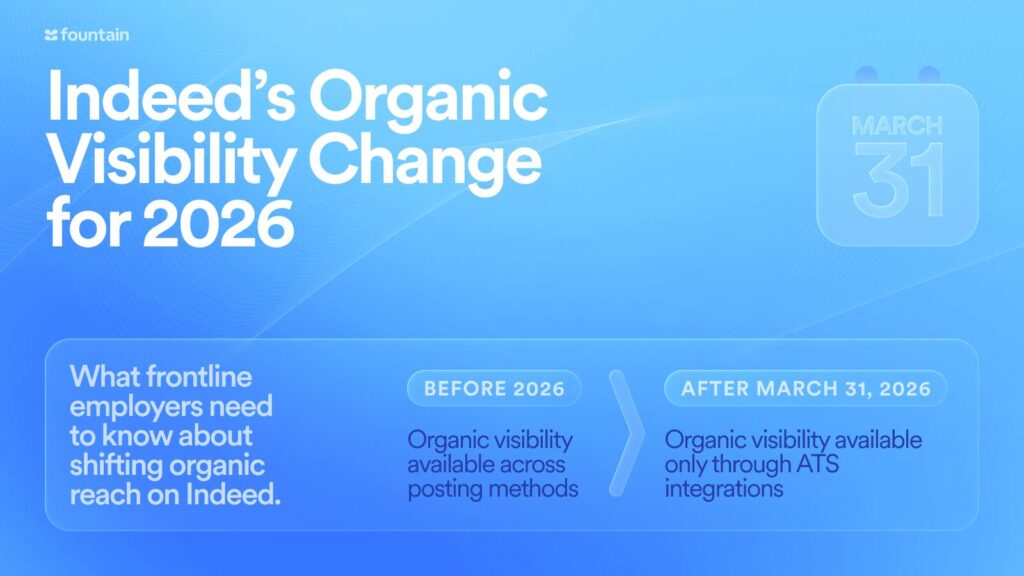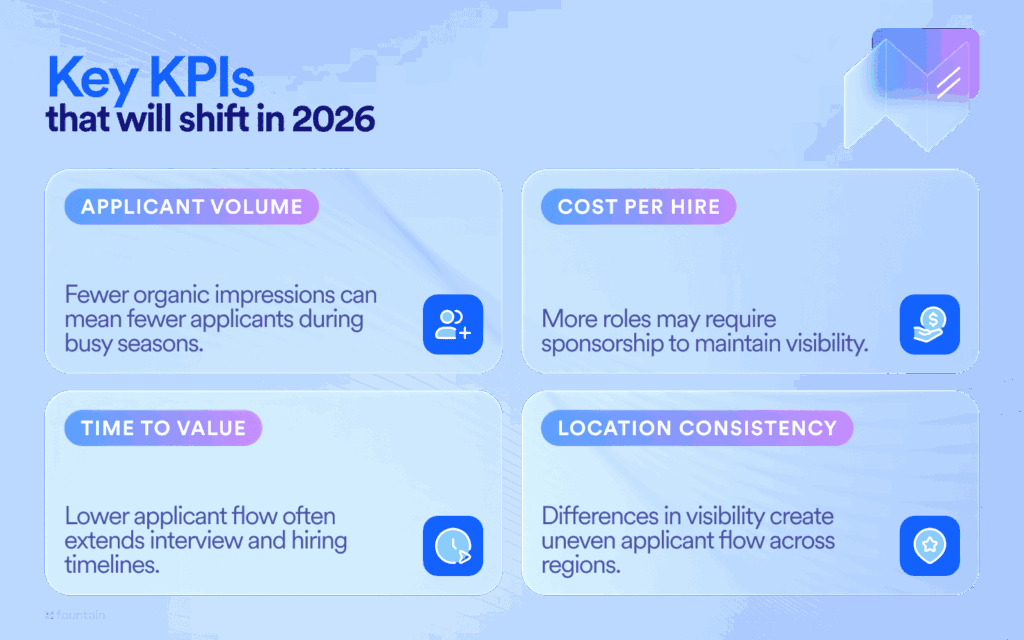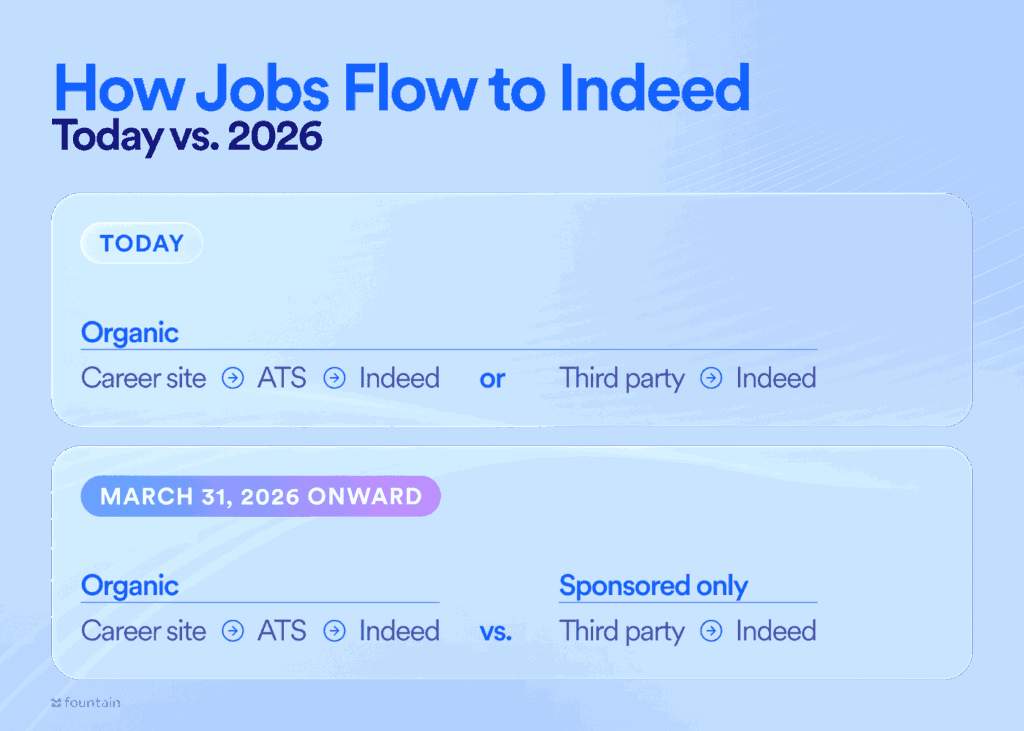
Hiring teams across frontline industries are entering a new chapter with Indeed. The upcoming 2026 organic visibility change will alter how jobs earn free placement, and for employers who depend on steady, high-volume applicant flow, the downstream effects are meaningful.
Frontline hiring moves at a different speed than traditional corporate recruiting, when fewer applicants come in, the effects spread and compound quickly. Shifts are harder to cover, schedules start slipping, and customers feel the difference. If the pipeline dries up, the rest of the operation can be impacted by understaffing.
That’s why it’s worth taking a closer look at what this change means and how to prepare. This report breaks down the specifics of Indeed’s policy change, how it affects frontline hiring, and what you can do to keep a steady stream of candidates coming in while optimizing spend.
What’s Changing in Indeed’s 2026 Organic Visibility Policy
Beginning March 31, 2026, roles sent to Indeed through single-source XML/API feeds will no longer receive free organic visibility if those jobs cannot be delivered through an Applicant Tracking System (ATS) that supports Indeed Apply.

Put simply, Indeed is narrowing access to free organic traffic and giving priority listing to jobs that come through an ATS integration or sponsored campaigns. Manually posted roles will surface less often in organic search unless they meet specific requirements.
Although these updates are meant to improve job quality and reduce duplicate postings, the effect of the Indeed 2026 organic visibility change on high-volume hiring teams is clear.
Indeed is positioning the change as a way to improve job seeker experience, posting quality and reduce duplicates, but the signal to frontline hiring teams is clear: employers that rely on third-party tools (other than an ATS) to post jobs to Indeed may see a drop in applicant volume.
Why These Changes Matter for Frontline Hiring Teams
Frontline hiring operates on thin time and cost margins, operators don’t have room for delays or gaps. Steady applicant flow is what keeps shifts covered, demand met, and daily operations on track. The policy change is expected to influence these critical KPIs:
- Applicant Volume. Fewer organic impressions mean fewer applicants, especially during peak hiring periods.
- Cost Per Hire. You may need to sponsor more roles than before just to maintain the level of visibility you’re used to.
- Time-to-Value. A drop in applicant flow often leads to delays, pushing out both the interview timeline and the overall time to hire.
- Location-Level Consistency. Frontline employers often manage dozens or hundreds of locations. Any disruption in sourcing can create uneven applicant flow across regions.
This update makes it essential that hiring teams audit their feed setup and proactively evaluate and diversify their sourcing strategy to reduce exposure to future policy shifts.

The Risks for High-Volume Employers
Frontline organizations are uniquely vulnerable to the impacts of this policy change. Some of the most immediate risks include:
- Limited Sourcing Mix. When one platform drives the majority of your applicant flow, changes in how that platform surfaces jobs can impact results. Diversifying your sources and monitoring channel data gives teams more control and flexibility.
- Higher Spend to Maintain Baseline Visibility. Roles that previously performed well without sponsorship may require budget allocation you did not plan for.
- Slower Hiring During Peak Cycles. Frontline demand rises and falls quickly. From peak seasons to sudden bumps in demand, your hiring plans rely on consistent candidate interest. Once that momentum drops, staying fully staffed becomes much harder.
- Inconsistent Recruiter Workflow. If recruiters react by manually reposting jobs or adjusting titles, it increases workload without guaranteeing better outcomes.
These risks are avoidable if you update your talent attraction strategy now.
How to Prepare for Indeed’s 2026 Changes
Below are practical steps frontline employers can take to stay ahead of these changes.
1. Confirm Your ATS Feed Setup
Make sure your jobs are being delivered through a compliant ATS multi-source feed. Roles that flow from an ATS or career site have a much better chance of keeping organic visibility. If you are still relying on manual posting or single-source feeds, now is the time to move to an approved integration.
2. Forecast the Budget Impact Ahead of 2026
As free visibility tightens, certain roles or locations may require sponsorship to maintain volume. Review your hiring needs and applicant flow patterns now so you can plan budgets proactively rather than reacting once performance dips.
3. Build a Targeted Sponsorship Strategy
Not every role needs sponsorship, but some will. Prioritize locations with historically low applicant volume or essential frontline positions that keep operations running. A targeted approach helps maximize ROI and avoids unnecessary spend.
4. Strengthen Your Multi-Channel Distribution
Expand your mix across social ads, community job boards, staffing partners, referral programs, and your existing talent pools. A broader distribution strategy gives you coverage when any single channel shifts its rules or performance.
5. Write Job Descriptions That Stand Out
Every job post should clearly state pay, shift details, any required equipment, and what growth looks like in the role. Strong, transparent job descriptions consistently convert better across all platforms.
6. Monitor Performance Metrics Closely
Look beyond total applicants. Track view-to-apply conversion, time-to-interview, location-level trends, and source-level performance. Better visibility into your data helps you make informed, timely decisions as the landscape changes.
7. Speed is Your Biggest Advantage
Frontline candidates move fast. Keep pace with immediate follow-up, mobile-first workflows, and smart, automated screening. The faster you move, the more likely you are to win qualified candidates before they engage with another employer.
Preparing now gives your team the clarity and control needed to weather these shifts with confidence. The employers who act early will protect applicant flow, reduce surprises, and stay fully staffed no matter how the landscape changes.

How Fountain’s Frontline OS Helps Teams Navigate Change
Frontline hiring depends on a network of partners, from job boards to background checks to HRIS and payroll systems. When any part of that ecosystem shifts, employers need a platform that can adapt quickly without slowing down operations. Frontline OS is built for exactly that.
With always-on automation, agentic AI that acts on behalf of your recruiters, mobile-first workflows, and real-time visibility into every sourcing and screening partner, Fountain gives teams the flexibility and control they need to stay fully staffed. And because humans stay in the loop at every critical decision point, your team retains full ownership over quality, compliance, and final hiring outcomes.
Employers use Frontline OS to:
- Keep applicant flow consistent across all locations
- Streamline repetitive recruiting tasks and reduce manual work
- Improve conversion from apply to interview with faster, mobile-friendly steps
- Understand which sources and partners drive the strongest results
- Move candidates from interest to hire with less friction
As platforms update their rules or introduce new requirements, Fountain helps teams adjust quickly and maintain momentum. It gives frontline employers one central system to manage partners, track performance, and make informed decisions so staffing stays on track even when the landscape changes.
Conclusion: Staying Ahead of Indeed’s 2026 Organic Visibility Change
The approaches that worked last year will not deliver the same results today. Teams that move quickly, stay close to their candidates, and maintain strong engagement throughout the process will be better positioned to navigate these changes.
If you want help refining your sourcing strategy or preparing for the shift ahead, our team can share proven best practices and show how Fountain’s automation and agentic AI support fast, consistent hiring with full human-in-the-loop oversight.


